Sustainability Report: Climate Change Impact on New Zealand Resources
VerifiedAdded on 2020/07/22
|13
|3589
|38
Report
AI Summary
This report provides a comprehensive analysis of sustainability, focusing on its definition, importance, and benefits. It examines sustainability from a New Zealand perspective, exploring its role in society, culture, and the natural ecosystem. The report delves into how sustainability affects society and lifestyle, emphasizing its necessity for the future. A significant portion is dedicated to climate change's impact on New Zealand, including rising temperatures, flooding, and resource depletion, while identifying responsible factors and suggesting measures for society, government, and organizations. The report concludes with key findings and recommendations for fostering sustainability in New Zealand, supported by illustrations and references.
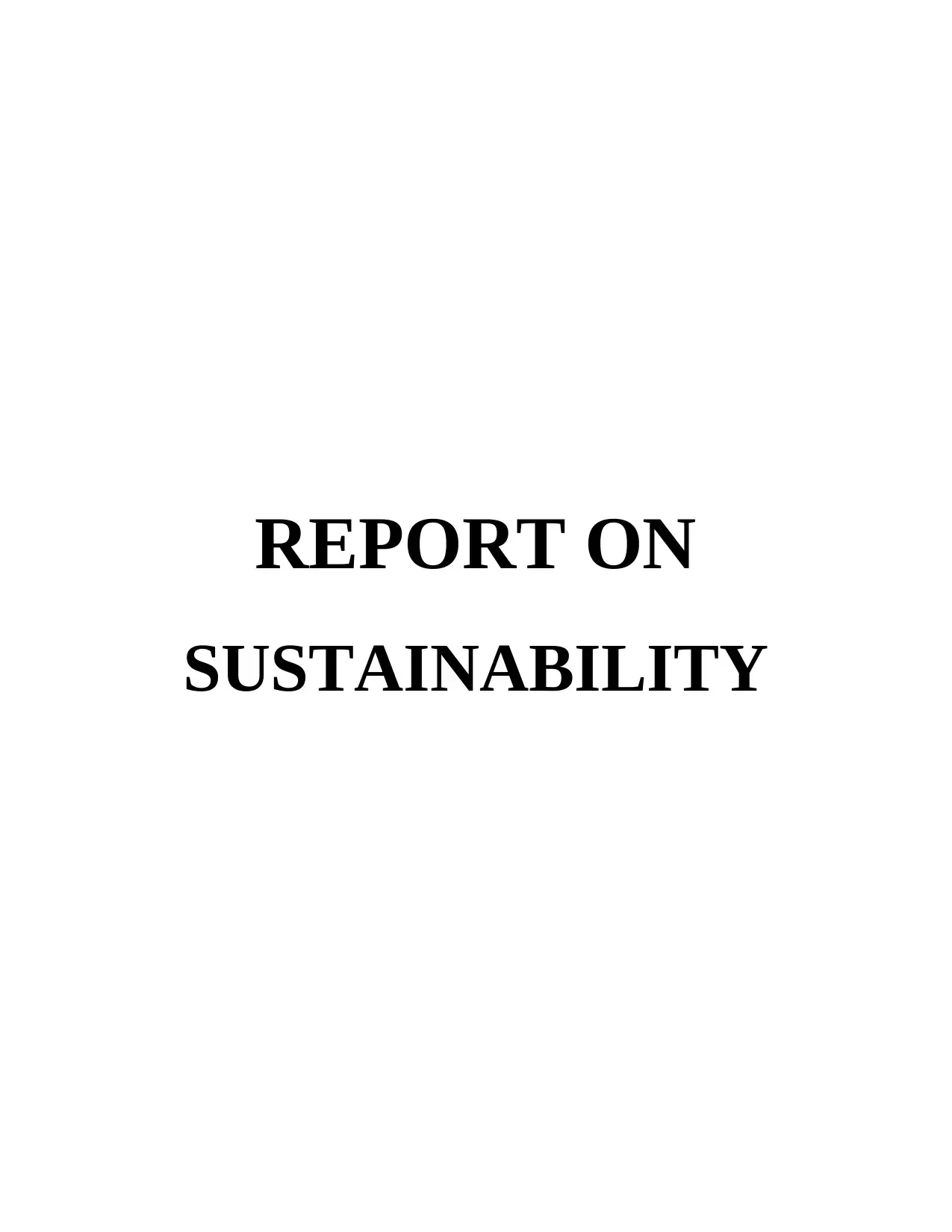
REPORT ON
SUSTAINABILITY
SUSTAINABILITY
Paraphrase This Document
Need a fresh take? Get an instant paraphrase of this document with our AI Paraphraser
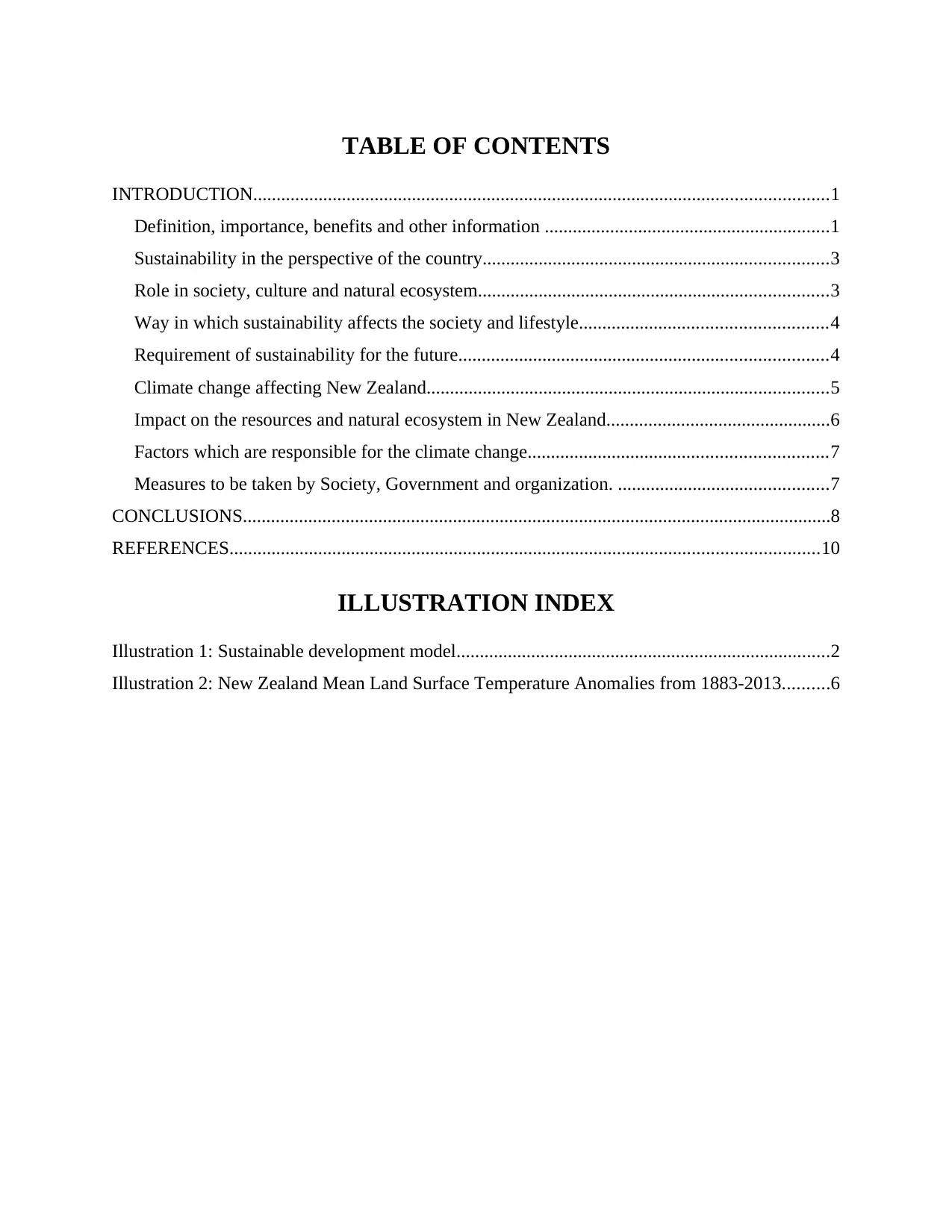
TABLE OF CONTENTS
INTRODUCTION...........................................................................................................................1
Definition, importance, benefits and other information .............................................................1
Sustainability in the perspective of the country..........................................................................3
Role in society, culture and natural ecosystem...........................................................................3
Way in which sustainability affects the society and lifestyle.....................................................4
Requirement of sustainability for the future...............................................................................4
Climate change affecting New Zealand......................................................................................5
Impact on the resources and natural ecosystem in New Zealand................................................6
Factors which are responsible for the climate change................................................................7
Measures to be taken by Society, Government and organization. .............................................7
CONCLUSIONS..............................................................................................................................8
REFERENCES..............................................................................................................................10
ILLUSTRATION INDEX
Illustration 1: Sustainable development model................................................................................2
Illustration 2: New Zealand Mean Land Surface Temperature Anomalies from 1883-2013..........6
INTRODUCTION...........................................................................................................................1
Definition, importance, benefits and other information .............................................................1
Sustainability in the perspective of the country..........................................................................3
Role in society, culture and natural ecosystem...........................................................................3
Way in which sustainability affects the society and lifestyle.....................................................4
Requirement of sustainability for the future...............................................................................4
Climate change affecting New Zealand......................................................................................5
Impact on the resources and natural ecosystem in New Zealand................................................6
Factors which are responsible for the climate change................................................................7
Measures to be taken by Society, Government and organization. .............................................7
CONCLUSIONS..............................................................................................................................8
REFERENCES..............................................................................................................................10
ILLUSTRATION INDEX
Illustration 1: Sustainable development model................................................................................2
Illustration 2: New Zealand Mean Land Surface Temperature Anomalies from 1883-2013..........6
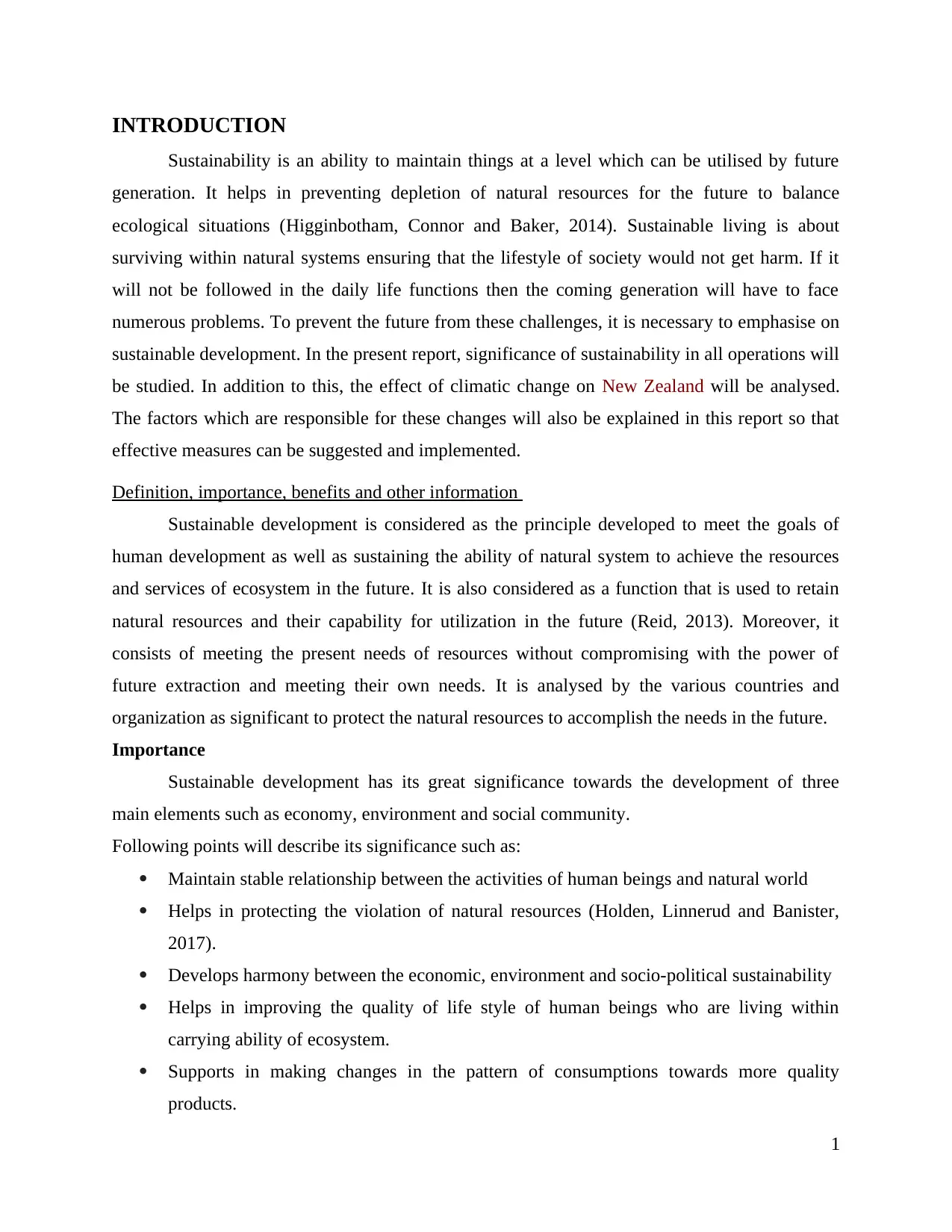
INTRODUCTION
Sustainability is an ability to maintain things at a level which can be utilised by future
generation. It helps in preventing depletion of natural resources for the future to balance
ecological situations (Higginbotham, Connor and Baker, 2014). Sustainable living is about
surviving within natural systems ensuring that the lifestyle of society would not get harm. If it
will not be followed in the daily life functions then the coming generation will have to face
numerous problems. To prevent the future from these challenges, it is necessary to emphasise on
sustainable development. In the present report, significance of sustainability in all operations will
be studied. In addition to this, the effect of climatic change on New Zealand will be analysed.
The factors which are responsible for these changes will also be explained in this report so that
effective measures can be suggested and implemented.
Definition, importance, benefits and other information
Sustainable development is considered as the principle developed to meet the goals of
human development as well as sustaining the ability of natural system to achieve the resources
and services of ecosystem in the future. It is also considered as a function that is used to retain
natural resources and their capability for utilization in the future (Reid, 2013). Moreover, it
consists of meeting the present needs of resources without compromising with the power of
future extraction and meeting their own needs. It is analysed by the various countries and
organization as significant to protect the natural resources to accomplish the needs in the future.
Importance
Sustainable development has its great significance towards the development of three
main elements such as economy, environment and social community.
Following points will describe its significance such as:
Maintain stable relationship between the activities of human beings and natural world
Helps in protecting the violation of natural resources (Holden, Linnerud and Banister,
2017).
Develops harmony between the economic, environment and socio-political sustainability
Helps in improving the quality of life style of human beings who are living within
carrying ability of ecosystem.
Supports in making changes in the pattern of consumptions towards more quality
products.
1
Sustainability is an ability to maintain things at a level which can be utilised by future
generation. It helps in preventing depletion of natural resources for the future to balance
ecological situations (Higginbotham, Connor and Baker, 2014). Sustainable living is about
surviving within natural systems ensuring that the lifestyle of society would not get harm. If it
will not be followed in the daily life functions then the coming generation will have to face
numerous problems. To prevent the future from these challenges, it is necessary to emphasise on
sustainable development. In the present report, significance of sustainability in all operations will
be studied. In addition to this, the effect of climatic change on New Zealand will be analysed.
The factors which are responsible for these changes will also be explained in this report so that
effective measures can be suggested and implemented.
Definition, importance, benefits and other information
Sustainable development is considered as the principle developed to meet the goals of
human development as well as sustaining the ability of natural system to achieve the resources
and services of ecosystem in the future. It is also considered as a function that is used to retain
natural resources and their capability for utilization in the future (Reid, 2013). Moreover, it
consists of meeting the present needs of resources without compromising with the power of
future extraction and meeting their own needs. It is analysed by the various countries and
organization as significant to protect the natural resources to accomplish the needs in the future.
Importance
Sustainable development has its great significance towards the development of three
main elements such as economy, environment and social community.
Following points will describe its significance such as:
Maintain stable relationship between the activities of human beings and natural world
Helps in protecting the violation of natural resources (Holden, Linnerud and Banister,
2017).
Develops harmony between the economic, environment and socio-political sustainability
Helps in improving the quality of life style of human beings who are living within
carrying ability of ecosystem.
Supports in making changes in the pattern of consumptions towards more quality
products.
1
⊘ This is a preview!⊘
Do you want full access?
Subscribe today to unlock all pages.

Trusted by 1+ million students worldwide
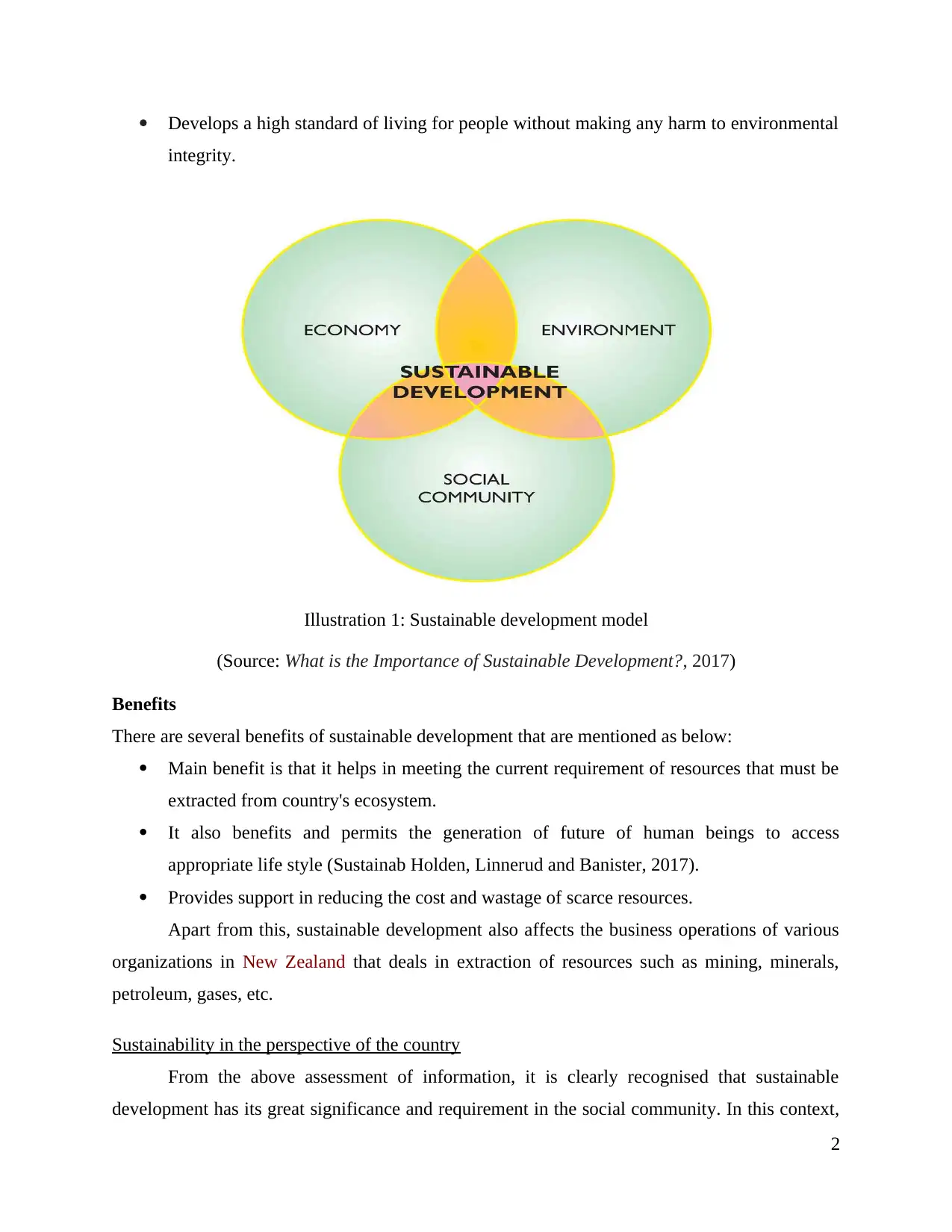
Develops a high standard of living for people without making any harm to environmental
integrity.
Benefits
There are several benefits of sustainable development that are mentioned as below:
Main benefit is that it helps in meeting the current requirement of resources that must be
extracted from country's ecosystem.
It also benefits and permits the generation of future of human beings to access
appropriate life style (Sustainab Holden, Linnerud and Banister, 2017).
Provides support in reducing the cost and wastage of scarce resources.
Apart from this, sustainable development also affects the business operations of various
organizations in New Zealand that deals in extraction of resources such as mining, minerals,
petroleum, gases, etc.
Sustainability in the perspective of the country
From the above assessment of information, it is clearly recognised that sustainable
development has its great significance and requirement in the social community. In this context,
2
Illustration 1: Sustainable development model
(Source: What is the Importance of Sustainable Development?, 2017)
integrity.
Benefits
There are several benefits of sustainable development that are mentioned as below:
Main benefit is that it helps in meeting the current requirement of resources that must be
extracted from country's ecosystem.
It also benefits and permits the generation of future of human beings to access
appropriate life style (Sustainab Holden, Linnerud and Banister, 2017).
Provides support in reducing the cost and wastage of scarce resources.
Apart from this, sustainable development also affects the business operations of various
organizations in New Zealand that deals in extraction of resources such as mining, minerals,
petroleum, gases, etc.
Sustainability in the perspective of the country
From the above assessment of information, it is clearly recognised that sustainable
development has its great significance and requirement in the social community. In this context,
2
Illustration 1: Sustainable development model
(Source: What is the Importance of Sustainable Development?, 2017)
Paraphrase This Document
Need a fresh take? Get an instant paraphrase of this document with our AI Paraphraser
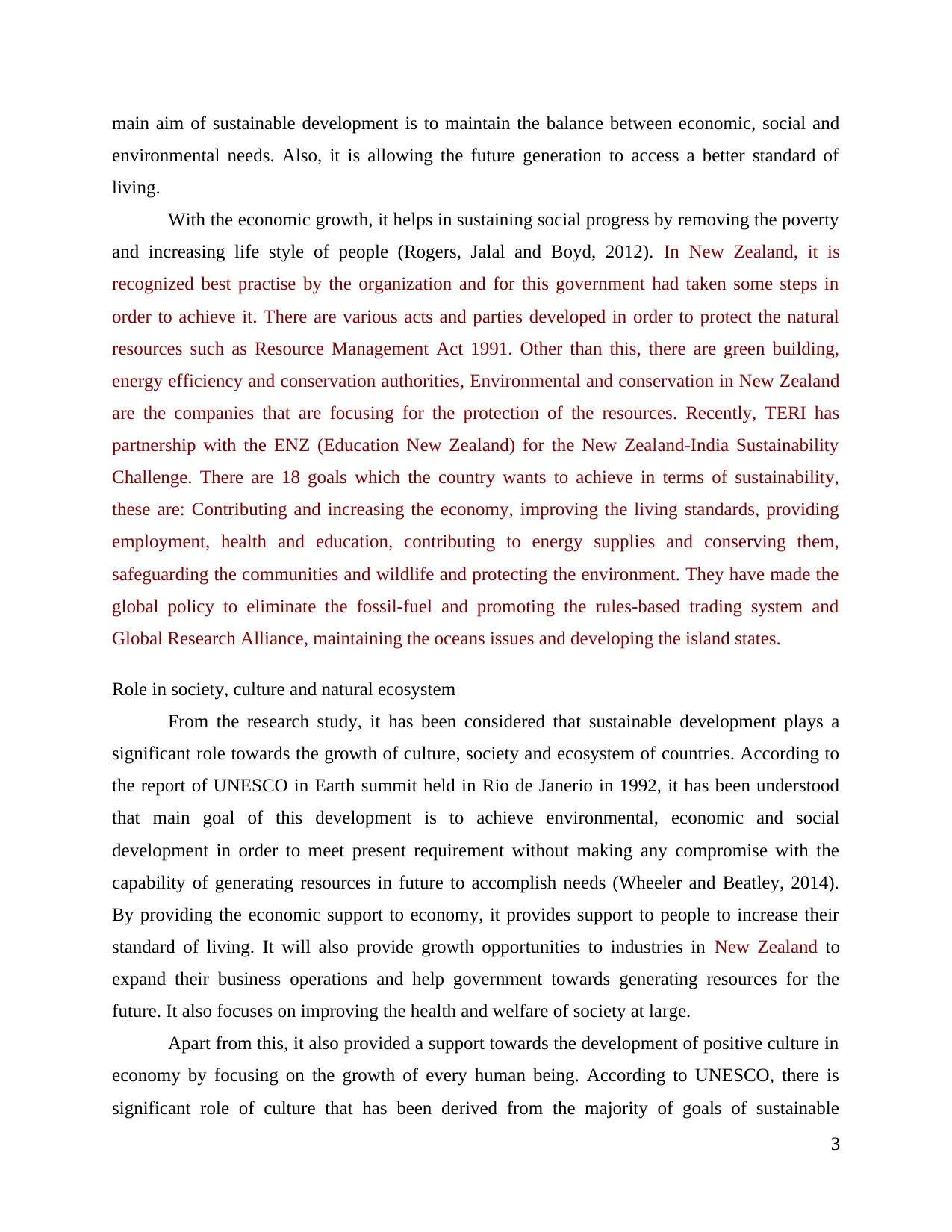
main aim of sustainable development is to maintain the balance between economic, social and
environmental needs. Also, it is allowing the future generation to access a better standard of
living.
With the economic growth, it helps in sustaining social progress by removing the poverty
and increasing life style of people (Rogers, Jalal and Boyd, 2012). In New Zealand, it is
recognized best practise by the organization and for this government had taken some steps in
order to achieve it. There are various acts and parties developed in order to protect the natural
resources such as Resource Management Act 1991. Other than this, there are green building,
energy efficiency and conservation authorities, Environmental and conservation in New Zealand
are the companies that are focusing for the protection of the resources. Recently, TERI has
partnership with the ENZ (Education New Zealand) for the New Zealand-India Sustainability
Challenge. There are 18 goals which the country wants to achieve in terms of sustainability,
these are: Contributing and increasing the economy, improving the living standards, providing
employment, health and education, contributing to energy supplies and conserving them,
safeguarding the communities and wildlife and protecting the environment. They have made the
global policy to eliminate the fossil-fuel and promoting the rules-based trading system and
Global Research Alliance, maintaining the oceans issues and developing the island states.
Role in society, culture and natural ecosystem
From the research study, it has been considered that sustainable development plays a
significant role towards the growth of culture, society and ecosystem of countries. According to
the report of UNESCO in Earth summit held in Rio de Janerio in 1992, it has been understood
that main goal of this development is to achieve environmental, economic and social
development in order to meet present requirement without making any compromise with the
capability of generating resources in future to accomplish needs (Wheeler and Beatley, 2014).
By providing the economic support to economy, it provides support to people to increase their
standard of living. It will also provide growth opportunities to industries in New Zealand to
expand their business operations and help government towards generating resources for the
future. It also focuses on improving the health and welfare of society at large.
Apart from this, it also provided a support towards the development of positive culture in
economy by focusing on the growth of every human being. According to UNESCO, there is
significant role of culture that has been derived from the majority of goals of sustainable
3
environmental needs. Also, it is allowing the future generation to access a better standard of
living.
With the economic growth, it helps in sustaining social progress by removing the poverty
and increasing life style of people (Rogers, Jalal and Boyd, 2012). In New Zealand, it is
recognized best practise by the organization and for this government had taken some steps in
order to achieve it. There are various acts and parties developed in order to protect the natural
resources such as Resource Management Act 1991. Other than this, there are green building,
energy efficiency and conservation authorities, Environmental and conservation in New Zealand
are the companies that are focusing for the protection of the resources. Recently, TERI has
partnership with the ENZ (Education New Zealand) for the New Zealand-India Sustainability
Challenge. There are 18 goals which the country wants to achieve in terms of sustainability,
these are: Contributing and increasing the economy, improving the living standards, providing
employment, health and education, contributing to energy supplies and conserving them,
safeguarding the communities and wildlife and protecting the environment. They have made the
global policy to eliminate the fossil-fuel and promoting the rules-based trading system and
Global Research Alliance, maintaining the oceans issues and developing the island states.
Role in society, culture and natural ecosystem
From the research study, it has been considered that sustainable development plays a
significant role towards the growth of culture, society and ecosystem of countries. According to
the report of UNESCO in Earth summit held in Rio de Janerio in 1992, it has been understood
that main goal of this development is to achieve environmental, economic and social
development in order to meet present requirement without making any compromise with the
capability of generating resources in future to accomplish needs (Wheeler and Beatley, 2014).
By providing the economic support to economy, it provides support to people to increase their
standard of living. It will also provide growth opportunities to industries in New Zealand to
expand their business operations and help government towards generating resources for the
future. It also focuses on improving the health and welfare of society at large.
Apart from this, it also provided a support towards the development of positive culture in
economy by focusing on the growth of every human being. According to UNESCO, there is
significant role of culture that has been derived from the majority of goals of sustainable
3
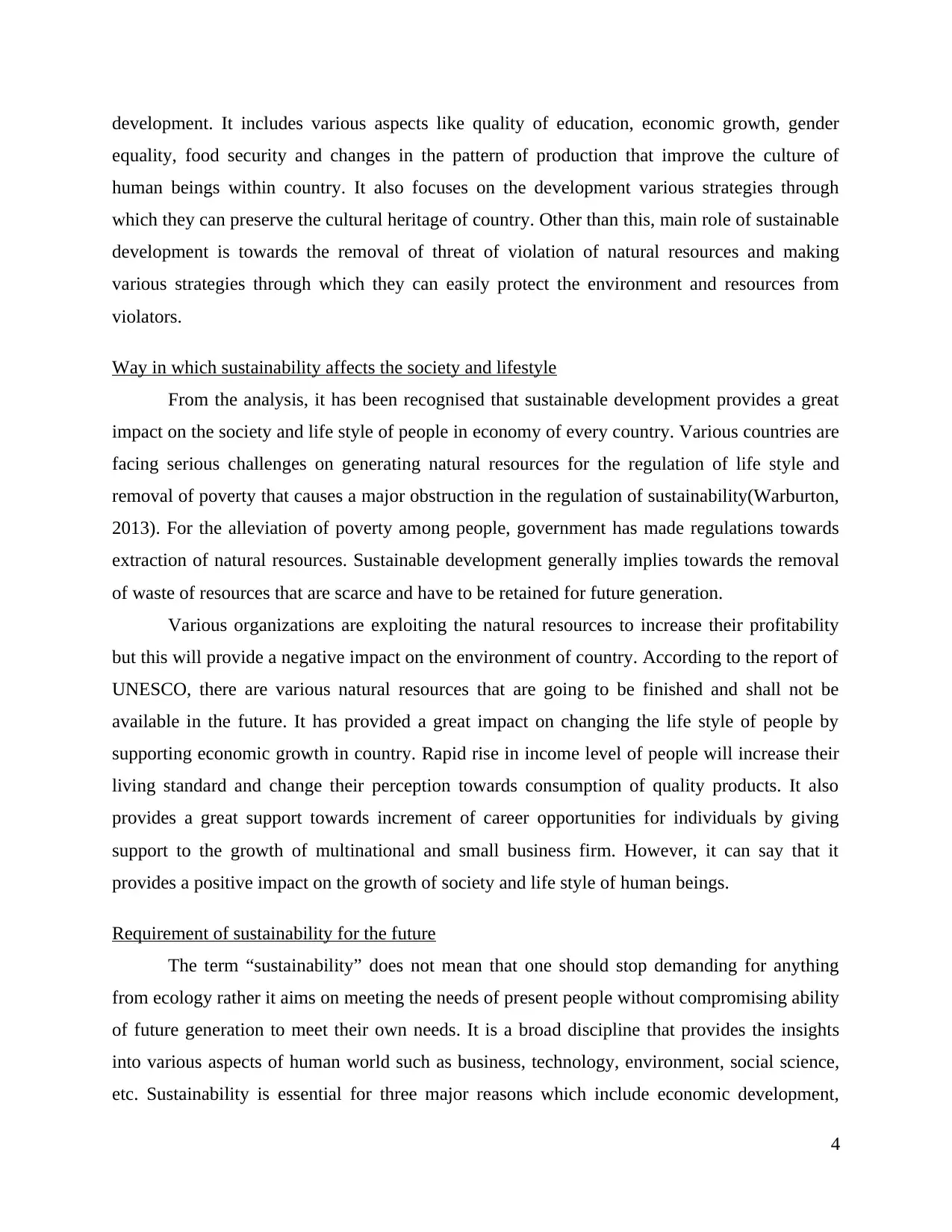
development. It includes various aspects like quality of education, economic growth, gender
equality, food security and changes in the pattern of production that improve the culture of
human beings within country. It also focuses on the development various strategies through
which they can preserve the cultural heritage of country. Other than this, main role of sustainable
development is towards the removal of threat of violation of natural resources and making
various strategies through which they can easily protect the environment and resources from
violators.
Way in which sustainability affects the society and lifestyle
From the analysis, it has been recognised that sustainable development provides a great
impact on the society and life style of people in economy of every country. Various countries are
facing serious challenges on generating natural resources for the regulation of life style and
removal of poverty that causes a major obstruction in the regulation of sustainability(Warburton,
2013). For the alleviation of poverty among people, government has made regulations towards
extraction of natural resources. Sustainable development generally implies towards the removal
of waste of resources that are scarce and have to be retained for future generation.
Various organizations are exploiting the natural resources to increase their profitability
but this will provide a negative impact on the environment of country. According to the report of
UNESCO, there are various natural resources that are going to be finished and shall not be
available in the future. It has provided a great impact on changing the life style of people by
supporting economic growth in country. Rapid rise in income level of people will increase their
living standard and change their perception towards consumption of quality products. It also
provides a great support towards increment of career opportunities for individuals by giving
support to the growth of multinational and small business firm. However, it can say that it
provides a positive impact on the growth of society and life style of human beings.
Requirement of sustainability for the future
The term “sustainability” does not mean that one should stop demanding for anything
from ecology rather it aims on meeting the needs of present people without compromising ability
of future generation to meet their own needs. It is a broad discipline that provides the insights
into various aspects of human world such as business, technology, environment, social science,
etc. Sustainability is essential for three major reasons which include economic development,
4
equality, food security and changes in the pattern of production that improve the culture of
human beings within country. It also focuses on the development various strategies through
which they can preserve the cultural heritage of country. Other than this, main role of sustainable
development is towards the removal of threat of violation of natural resources and making
various strategies through which they can easily protect the environment and resources from
violators.
Way in which sustainability affects the society and lifestyle
From the analysis, it has been recognised that sustainable development provides a great
impact on the society and life style of people in economy of every country. Various countries are
facing serious challenges on generating natural resources for the regulation of life style and
removal of poverty that causes a major obstruction in the regulation of sustainability(Warburton,
2013). For the alleviation of poverty among people, government has made regulations towards
extraction of natural resources. Sustainable development generally implies towards the removal
of waste of resources that are scarce and have to be retained for future generation.
Various organizations are exploiting the natural resources to increase their profitability
but this will provide a negative impact on the environment of country. According to the report of
UNESCO, there are various natural resources that are going to be finished and shall not be
available in the future. It has provided a great impact on changing the life style of people by
supporting economic growth in country. Rapid rise in income level of people will increase their
living standard and change their perception towards consumption of quality products. It also
provides a great support towards increment of career opportunities for individuals by giving
support to the growth of multinational and small business firm. However, it can say that it
provides a positive impact on the growth of society and life style of human beings.
Requirement of sustainability for the future
The term “sustainability” does not mean that one should stop demanding for anything
from ecology rather it aims on meeting the needs of present people without compromising ability
of future generation to meet their own needs. It is a broad discipline that provides the insights
into various aspects of human world such as business, technology, environment, social science,
etc. Sustainability is essential for three major reasons which include economic development,
4
⊘ This is a preview!⊘
Do you want full access?
Subscribe today to unlock all pages.

Trusted by 1+ million students worldwide
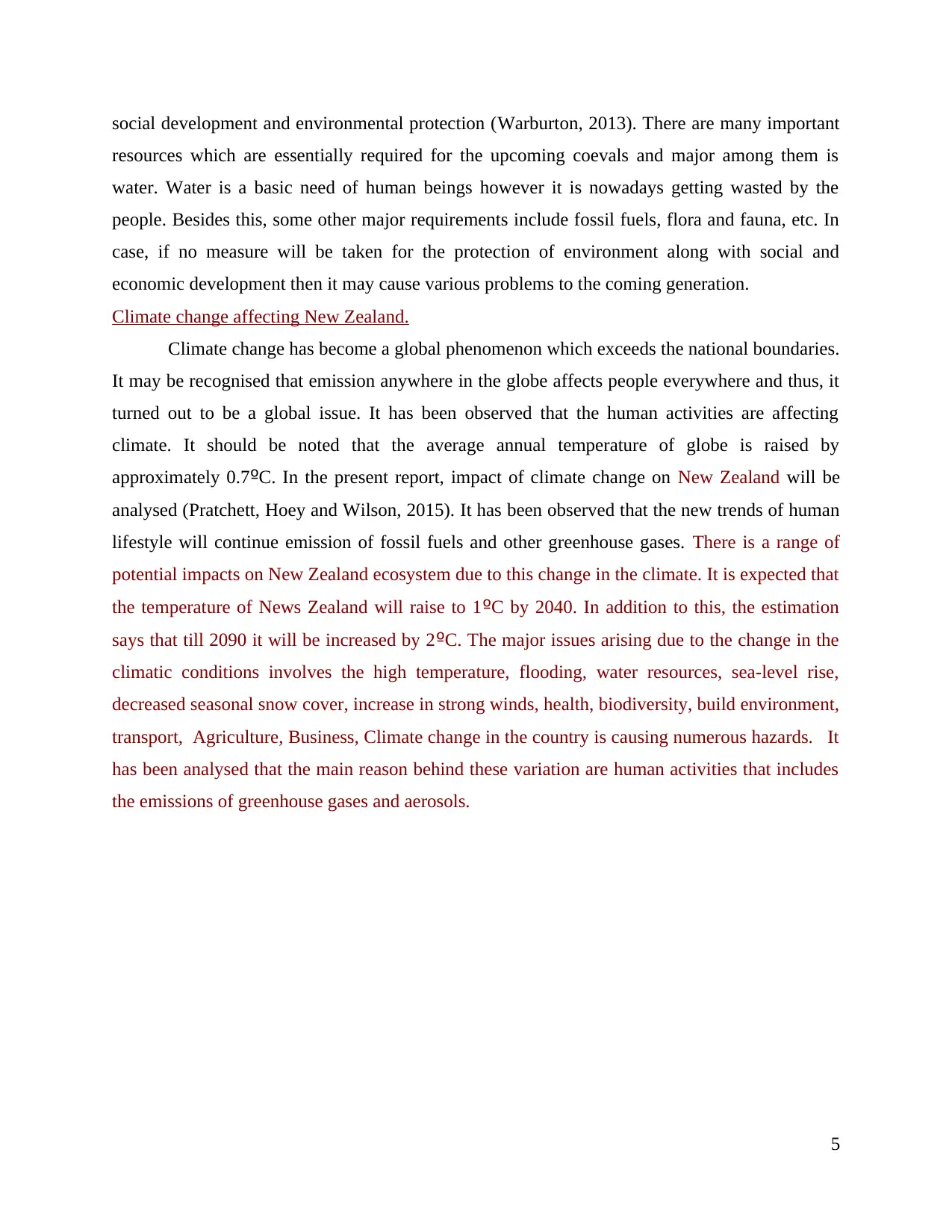
social development and environmental protection (Warburton, 2013). There are many important
resources which are essentially required for the upcoming coevals and major among them is
water. Water is a basic need of human beings however it is nowadays getting wasted by the
people. Besides this, some other major requirements include fossil fuels, flora and fauna, etc. In
case, if no measure will be taken for the protection of environment along with social and
economic development then it may cause various problems to the coming generation.
Climate change affecting New Zealand.
Climate change has become a global phenomenon which exceeds the national boundaries.
It may be recognised that emission anywhere in the globe affects people everywhere and thus, it
turned out to be a global issue. It has been observed that the human activities are affecting
climate. It should be noted that the average annual temperature of globe is raised by
approximately 0.7ºC. In the present report, impact of climate change on New Zealand will be
analysed (Pratchett, Hoey and Wilson, 2015). It has been observed that the new trends of human
lifestyle will continue emission of fossil fuels and other greenhouse gases. There is a range of
potential impacts on New Zealand ecosystem due to this change in the climate. It is expected that
the temperature of News Zealand will raise to 1ºC by 2040. In addition to this, the estimation
says that till 2090 it will be increased by 2ºC. The major issues arising due to the change in the
climatic conditions involves the high temperature, flooding, water resources, sea-level rise,
decreased seasonal snow cover, increase in strong winds, health, biodiversity, build environment,
transport, Agriculture, Business, Climate change in the country is causing numerous hazards. It
has been analysed that the main reason behind these variation are human activities that includes
the emissions of greenhouse gases and aerosols.
5
resources which are essentially required for the upcoming coevals and major among them is
water. Water is a basic need of human beings however it is nowadays getting wasted by the
people. Besides this, some other major requirements include fossil fuels, flora and fauna, etc. In
case, if no measure will be taken for the protection of environment along with social and
economic development then it may cause various problems to the coming generation.
Climate change affecting New Zealand.
Climate change has become a global phenomenon which exceeds the national boundaries.
It may be recognised that emission anywhere in the globe affects people everywhere and thus, it
turned out to be a global issue. It has been observed that the human activities are affecting
climate. It should be noted that the average annual temperature of globe is raised by
approximately 0.7ºC. In the present report, impact of climate change on New Zealand will be
analysed (Pratchett, Hoey and Wilson, 2015). It has been observed that the new trends of human
lifestyle will continue emission of fossil fuels and other greenhouse gases. There is a range of
potential impacts on New Zealand ecosystem due to this change in the climate. It is expected that
the temperature of News Zealand will raise to 1ºC by 2040. In addition to this, the estimation
says that till 2090 it will be increased by 2ºC. The major issues arising due to the change in the
climatic conditions involves the high temperature, flooding, water resources, sea-level rise,
decreased seasonal snow cover, increase in strong winds, health, biodiversity, build environment,
transport, Agriculture, Business, Climate change in the country is causing numerous hazards. It
has been analysed that the main reason behind these variation are human activities that includes
the emissions of greenhouse gases and aerosols.
5
Paraphrase This Document
Need a fresh take? Get an instant paraphrase of this document with our AI Paraphraser
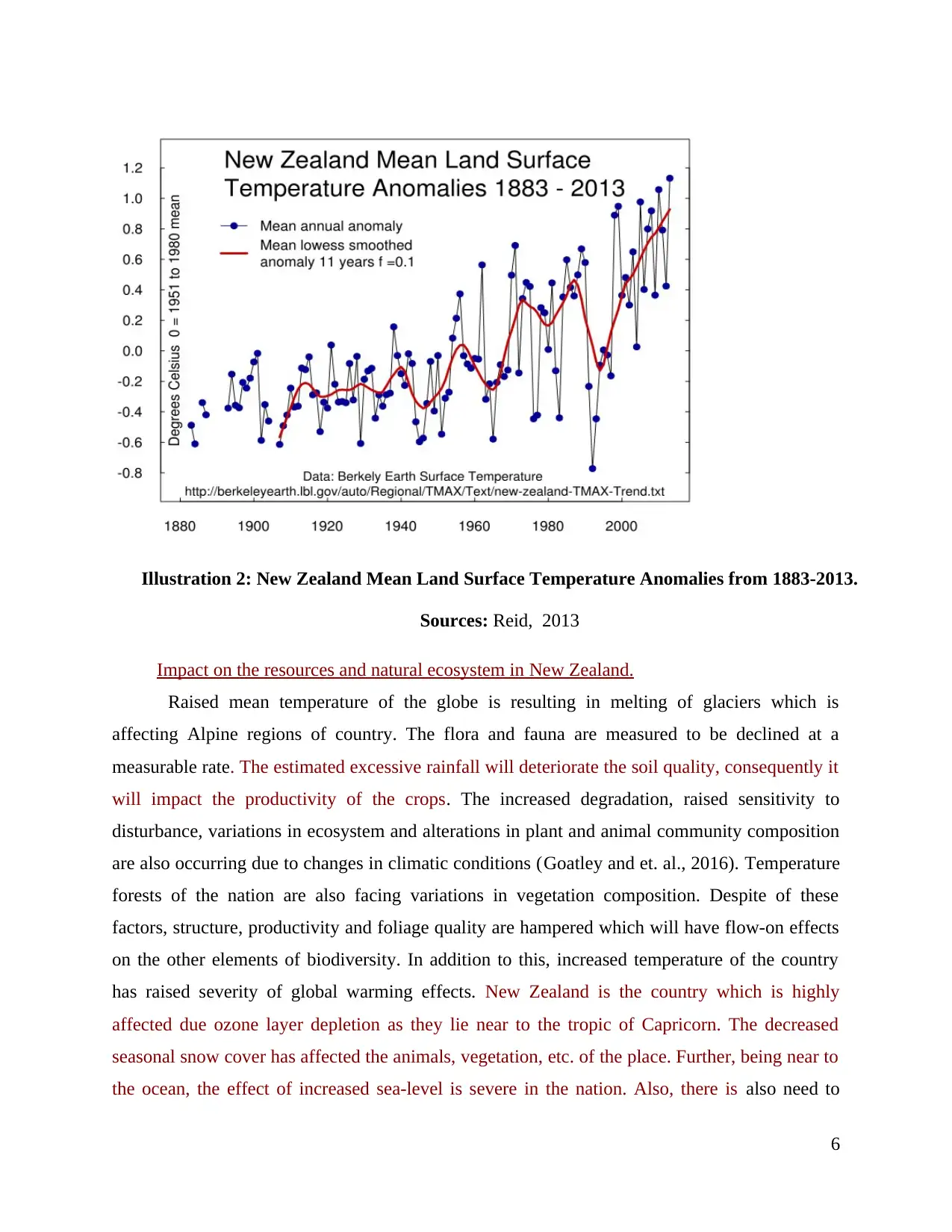
Illustration 2: New Zealand Mean Land Surface Temperature Anomalies from 1883-2013.
Sources: Reid, 2013
Impact on the resources and natural ecosystem in New Zealand.
Raised mean temperature of the globe is resulting in melting of glaciers which is
affecting Alpine regions of country. The flora and fauna are measured to be declined at a
measurable rate. The estimated excessive rainfall will deteriorate the soil quality, consequently it
will impact the productivity of the crops. The increased degradation, raised sensitivity to
disturbance, variations in ecosystem and alterations in plant and animal community composition
are also occurring due to changes in climatic conditions (Goatley and et. al., 2016). Temperature
forests of the nation are also facing variations in vegetation composition. Despite of these
factors, structure, productivity and foliage quality are hampered which will have flow-on effects
on the other elements of biodiversity. In addition to this, increased temperature of the country
has raised severity of global warming effects. New Zealand is the country which is highly
affected due ozone layer depletion as they lie near to the tropic of Capricorn. The decreased
seasonal snow cover has affected the animals, vegetation, etc. of the place. Further, being near to
the ocean, the effect of increased sea-level is severe in the nation. Also, there is also need to
6
Sources: Reid, 2013
Impact on the resources and natural ecosystem in New Zealand.
Raised mean temperature of the globe is resulting in melting of glaciers which is
affecting Alpine regions of country. The flora and fauna are measured to be declined at a
measurable rate. The estimated excessive rainfall will deteriorate the soil quality, consequently it
will impact the productivity of the crops. The increased degradation, raised sensitivity to
disturbance, variations in ecosystem and alterations in plant and animal community composition
are also occurring due to changes in climatic conditions (Goatley and et. al., 2016). Temperature
forests of the nation are also facing variations in vegetation composition. Despite of these
factors, structure, productivity and foliage quality are hampered which will have flow-on effects
on the other elements of biodiversity. In addition to this, increased temperature of the country
has raised severity of global warming effects. New Zealand is the country which is highly
affected due ozone layer depletion as they lie near to the tropic of Capricorn. The decreased
seasonal snow cover has affected the animals, vegetation, etc. of the place. Further, being near to
the ocean, the effect of increased sea-level is severe in the nation. Also, there is also need to
6
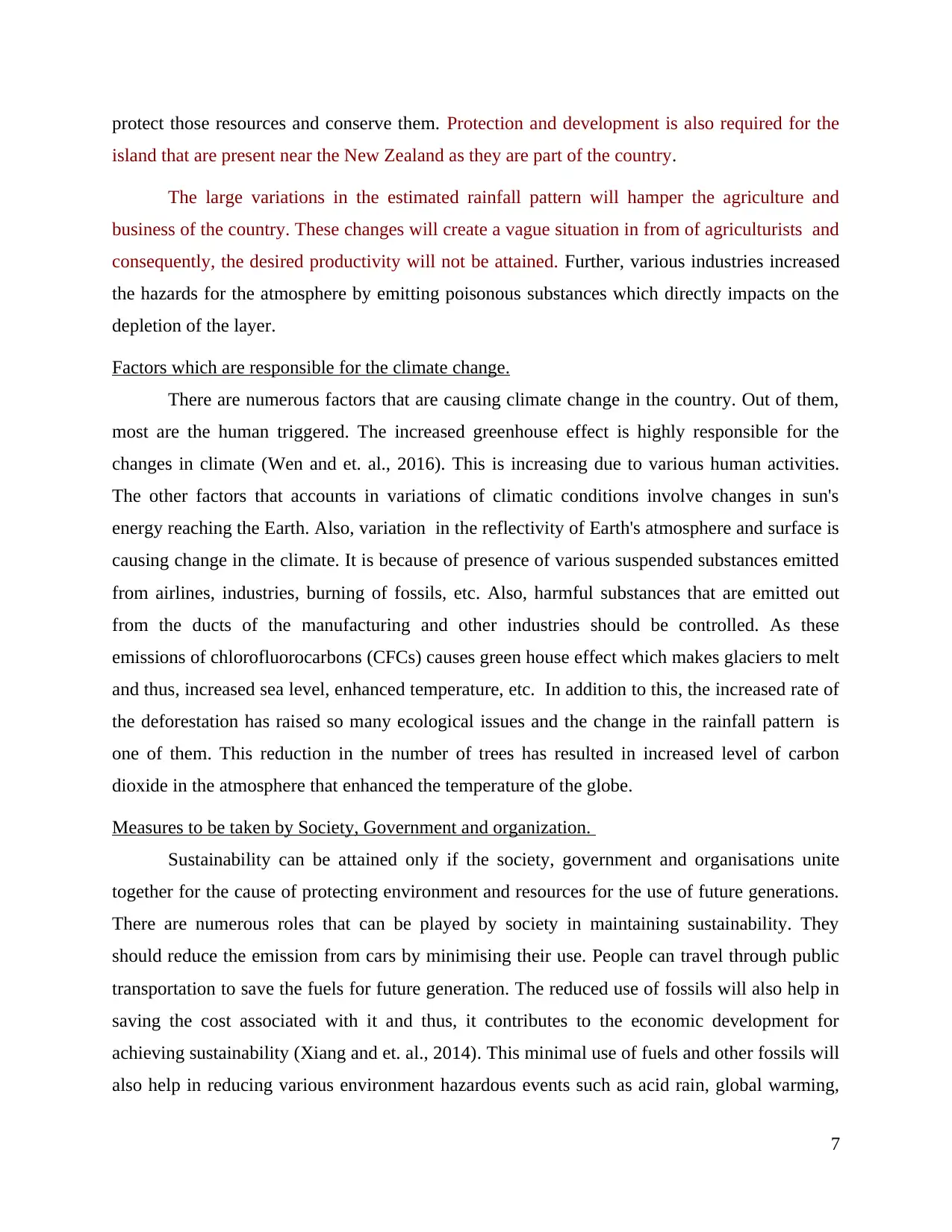
protect those resources and conserve them. Protection and development is also required for the
island that are present near the New Zealand as they are part of the country.
The large variations in the estimated rainfall pattern will hamper the agriculture and
business of the country. These changes will create a vague situation in from of agriculturists and
consequently, the desired productivity will not be attained. Further, various industries increased
the hazards for the atmosphere by emitting poisonous substances which directly impacts on the
depletion of the layer.
Factors which are responsible for the climate change.
There are numerous factors that are causing climate change in the country. Out of them,
most are the human triggered. The increased greenhouse effect is highly responsible for the
changes in climate (Wen and et. al., 2016). This is increasing due to various human activities.
The other factors that accounts in variations of climatic conditions involve changes in sun's
energy reaching the Earth. Also, variation in the reflectivity of Earth's atmosphere and surface is
causing change in the climate. It is because of presence of various suspended substances emitted
from airlines, industries, burning of fossils, etc. Also, harmful substances that are emitted out
from the ducts of the manufacturing and other industries should be controlled. As these
emissions of chlorofluorocarbons (CFCs) causes green house effect which makes glaciers to melt
and thus, increased sea level, enhanced temperature, etc. In addition to this, the increased rate of
the deforestation has raised so many ecological issues and the change in the rainfall pattern is
one of them. This reduction in the number of trees has resulted in increased level of carbon
dioxide in the atmosphere that enhanced the temperature of the globe.
Measures to be taken by Society, Government and organization.
Sustainability can be attained only if the society, government and organisations unite
together for the cause of protecting environment and resources for the use of future generations.
There are numerous roles that can be played by society in maintaining sustainability. They
should reduce the emission from cars by minimising their use. People can travel through public
transportation to save the fuels for future generation. The reduced use of fossils will also help in
saving the cost associated with it and thus, it contributes to the economic development for
achieving sustainability (Xiang and et. al., 2014). This minimal use of fuels and other fossils will
also help in reducing various environment hazardous events such as acid rain, global warming,
7
island that are present near the New Zealand as they are part of the country.
The large variations in the estimated rainfall pattern will hamper the agriculture and
business of the country. These changes will create a vague situation in from of agriculturists and
consequently, the desired productivity will not be attained. Further, various industries increased
the hazards for the atmosphere by emitting poisonous substances which directly impacts on the
depletion of the layer.
Factors which are responsible for the climate change.
There are numerous factors that are causing climate change in the country. Out of them,
most are the human triggered. The increased greenhouse effect is highly responsible for the
changes in climate (Wen and et. al., 2016). This is increasing due to various human activities.
The other factors that accounts in variations of climatic conditions involve changes in sun's
energy reaching the Earth. Also, variation in the reflectivity of Earth's atmosphere and surface is
causing change in the climate. It is because of presence of various suspended substances emitted
from airlines, industries, burning of fossils, etc. Also, harmful substances that are emitted out
from the ducts of the manufacturing and other industries should be controlled. As these
emissions of chlorofluorocarbons (CFCs) causes green house effect which makes glaciers to melt
and thus, increased sea level, enhanced temperature, etc. In addition to this, the increased rate of
the deforestation has raised so many ecological issues and the change in the rainfall pattern is
one of them. This reduction in the number of trees has resulted in increased level of carbon
dioxide in the atmosphere that enhanced the temperature of the globe.
Measures to be taken by Society, Government and organization.
Sustainability can be attained only if the society, government and organisations unite
together for the cause of protecting environment and resources for the use of future generations.
There are numerous roles that can be played by society in maintaining sustainability. They
should reduce the emission from cars by minimising their use. People can travel through public
transportation to save the fuels for future generation. The reduced use of fossils will also help in
saving the cost associated with it and thus, it contributes to the economic development for
achieving sustainability (Xiang and et. al., 2014). This minimal use of fuels and other fossils will
also help in reducing various environment hazardous events such as acid rain, global warming,
7
⊘ This is a preview!⊘
Do you want full access?
Subscribe today to unlock all pages.

Trusted by 1+ million students worldwide
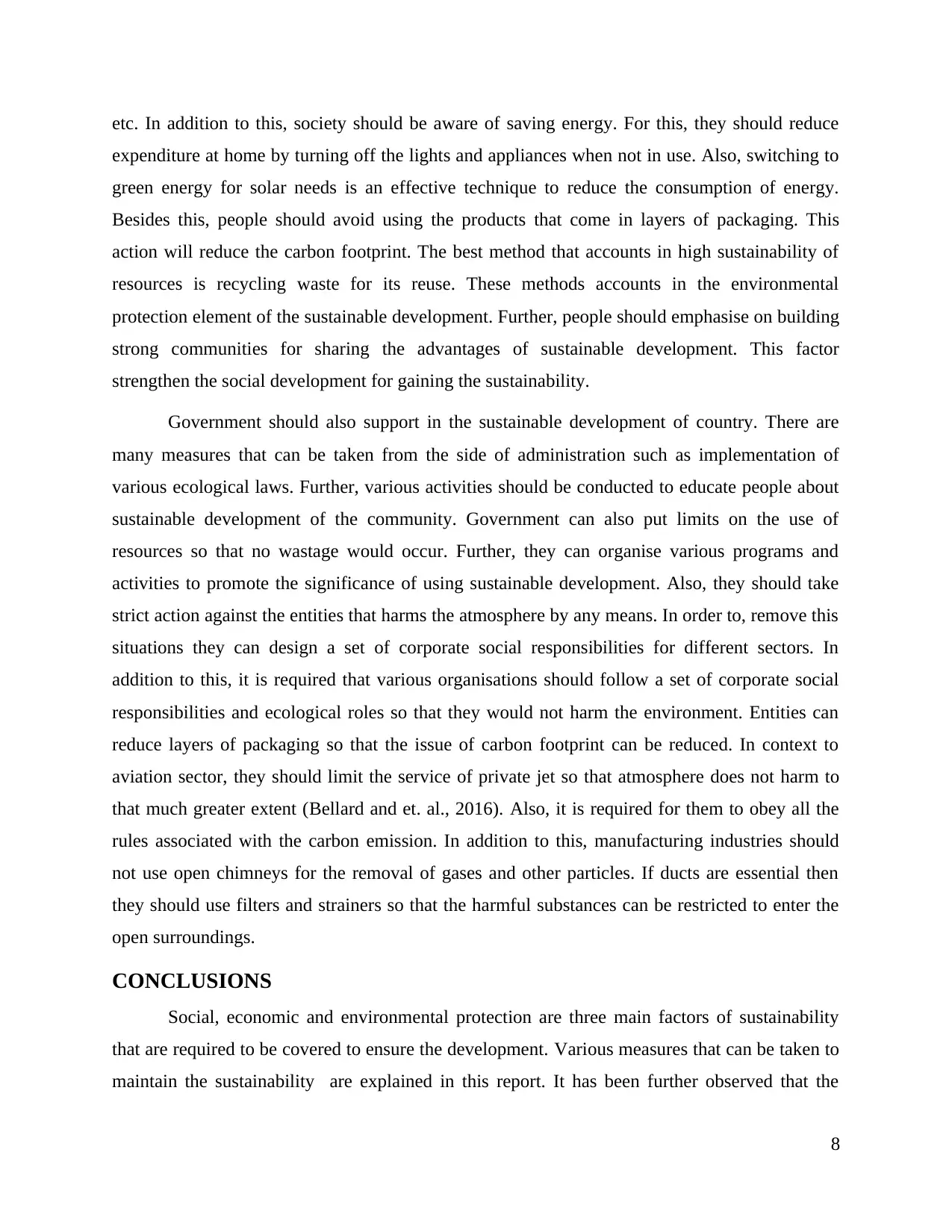
etc. In addition to this, society should be aware of saving energy. For this, they should reduce
expenditure at home by turning off the lights and appliances when not in use. Also, switching to
green energy for solar needs is an effective technique to reduce the consumption of energy.
Besides this, people should avoid using the products that come in layers of packaging. This
action will reduce the carbon footprint. The best method that accounts in high sustainability of
resources is recycling waste for its reuse. These methods accounts in the environmental
protection element of the sustainable development. Further, people should emphasise on building
strong communities for sharing the advantages of sustainable development. This factor
strengthen the social development for gaining the sustainability.
Government should also support in the sustainable development of country. There are
many measures that can be taken from the side of administration such as implementation of
various ecological laws. Further, various activities should be conducted to educate people about
sustainable development of the community. Government can also put limits on the use of
resources so that no wastage would occur. Further, they can organise various programs and
activities to promote the significance of using sustainable development. Also, they should take
strict action against the entities that harms the atmosphere by any means. In order to, remove this
situations they can design a set of corporate social responsibilities for different sectors. In
addition to this, it is required that various organisations should follow a set of corporate social
responsibilities and ecological roles so that they would not harm the environment. Entities can
reduce layers of packaging so that the issue of carbon footprint can be reduced. In context to
aviation sector, they should limit the service of private jet so that atmosphere does not harm to
that much greater extent (Bellard and et. al., 2016). Also, it is required for them to obey all the
rules associated with the carbon emission. In addition to this, manufacturing industries should
not use open chimneys for the removal of gases and other particles. If ducts are essential then
they should use filters and strainers so that the harmful substances can be restricted to enter the
open surroundings.
CONCLUSIONS
Social, economic and environmental protection are three main factors of sustainability
that are required to be covered to ensure the development. Various measures that can be taken to
maintain the sustainability are explained in this report. It has been further observed that the
8
expenditure at home by turning off the lights and appliances when not in use. Also, switching to
green energy for solar needs is an effective technique to reduce the consumption of energy.
Besides this, people should avoid using the products that come in layers of packaging. This
action will reduce the carbon footprint. The best method that accounts in high sustainability of
resources is recycling waste for its reuse. These methods accounts in the environmental
protection element of the sustainable development. Further, people should emphasise on building
strong communities for sharing the advantages of sustainable development. This factor
strengthen the social development for gaining the sustainability.
Government should also support in the sustainable development of country. There are
many measures that can be taken from the side of administration such as implementation of
various ecological laws. Further, various activities should be conducted to educate people about
sustainable development of the community. Government can also put limits on the use of
resources so that no wastage would occur. Further, they can organise various programs and
activities to promote the significance of using sustainable development. Also, they should take
strict action against the entities that harms the atmosphere by any means. In order to, remove this
situations they can design a set of corporate social responsibilities for different sectors. In
addition to this, it is required that various organisations should follow a set of corporate social
responsibilities and ecological roles so that they would not harm the environment. Entities can
reduce layers of packaging so that the issue of carbon footprint can be reduced. In context to
aviation sector, they should limit the service of private jet so that atmosphere does not harm to
that much greater extent (Bellard and et. al., 2016). Also, it is required for them to obey all the
rules associated with the carbon emission. In addition to this, manufacturing industries should
not use open chimneys for the removal of gases and other particles. If ducts are essential then
they should use filters and strainers so that the harmful substances can be restricted to enter the
open surroundings.
CONCLUSIONS
Social, economic and environmental protection are three main factors of sustainability
that are required to be covered to ensure the development. Various measures that can be taken to
maintain the sustainability are explained in this report. It has been further observed that the
8
Paraphrase This Document
Need a fresh take? Get an instant paraphrase of this document with our AI Paraphraser

unsustainable management leads to climate change that has caused numerous problems to the
biodiversity of New Zealand. The factors that cause this issue are also studied so that effective
measures can be applied to resolve it.
9
biodiversity of New Zealand. The factors that cause this issue are also studied so that effective
measures can be applied to resolve it.
9
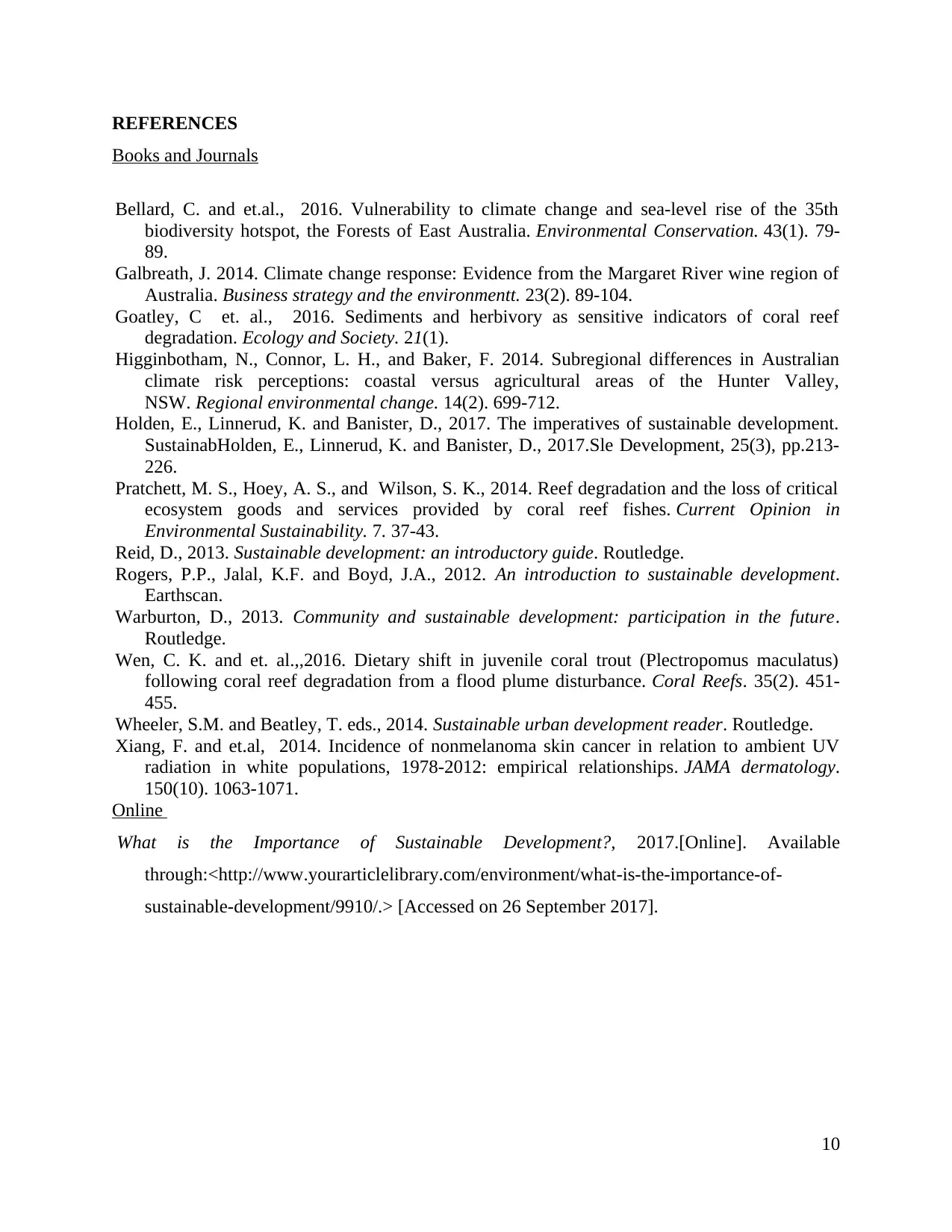
REFERENCES
Books and Journals
Bellard, C. and et.al., 2016. Vulnerability to climate change and sea-level rise of the 35th
biodiversity hotspot, the Forests of East Australia. Environmental Conservation. 43(1). 79-
89.
Galbreath, J. 2014. Climate change response: Evidence from the Margaret River wine region of
Australia. Business strategy and the environmentt. 23(2). 89-104.
Goatley, C et. al., 2016. Sediments and herbivory as sensitive indicators of coral reef
degradation. Ecology and Society. 21(1).
Higginbotham, N., Connor, L. H., and Baker, F. 2014. Subregional differences in Australian
climate risk perceptions: coastal versus agricultural areas of the Hunter Valley,
NSW. Regional environmental change. 14(2). 699-712.
Holden, E., Linnerud, K. and Banister, D., 2017. The imperatives of sustainable development.
SustainabHolden, E., Linnerud, K. and Banister, D., 2017.Sle Development, 25(3), pp.213-
226.
Pratchett, M. S., Hoey, A. S., and Wilson, S. K., 2014. Reef degradation and the loss of critical
ecosystem goods and services provided by coral reef fishes. Current Opinion in
Environmental Sustainability. 7. 37-43.
Reid, D., 2013. Sustainable development: an introductory guide. Routledge.
Rogers, P.P., Jalal, K.F. and Boyd, J.A., 2012. An introduction to sustainable development.
Earthscan.
Warburton, D., 2013. Community and sustainable development: participation in the future.
Routledge.
Wen, C. K. and et. al.,,2016. Dietary shift in juvenile coral trout (Plectropomus maculatus)
following coral reef degradation from a flood plume disturbance. Coral Reefs. 35(2). 451-
455.
Wheeler, S.M. and Beatley, T. eds., 2014. Sustainable urban development reader. Routledge.
Xiang, F. and et.al, 2014. Incidence of nonmelanoma skin cancer in relation to ambient UV
radiation in white populations, 1978-2012: empirical relationships. JAMA dermatology.
150(10). 1063-1071.
Online
What is the Importance of Sustainable Development?, 2017.[Online]. Available
through:<http://www.yourarticlelibrary.com/environment/what-is-the-importance-of-
sustainable-development/9910/.> [Accessed on 26 September 2017].
10
Books and Journals
Bellard, C. and et.al., 2016. Vulnerability to climate change and sea-level rise of the 35th
biodiversity hotspot, the Forests of East Australia. Environmental Conservation. 43(1). 79-
89.
Galbreath, J. 2014. Climate change response: Evidence from the Margaret River wine region of
Australia. Business strategy and the environmentt. 23(2). 89-104.
Goatley, C et. al., 2016. Sediments and herbivory as sensitive indicators of coral reef
degradation. Ecology and Society. 21(1).
Higginbotham, N., Connor, L. H., and Baker, F. 2014. Subregional differences in Australian
climate risk perceptions: coastal versus agricultural areas of the Hunter Valley,
NSW. Regional environmental change. 14(2). 699-712.
Holden, E., Linnerud, K. and Banister, D., 2017. The imperatives of sustainable development.
SustainabHolden, E., Linnerud, K. and Banister, D., 2017.Sle Development, 25(3), pp.213-
226.
Pratchett, M. S., Hoey, A. S., and Wilson, S. K., 2014. Reef degradation and the loss of critical
ecosystem goods and services provided by coral reef fishes. Current Opinion in
Environmental Sustainability. 7. 37-43.
Reid, D., 2013. Sustainable development: an introductory guide. Routledge.
Rogers, P.P., Jalal, K.F. and Boyd, J.A., 2012. An introduction to sustainable development.
Earthscan.
Warburton, D., 2013. Community and sustainable development: participation in the future.
Routledge.
Wen, C. K. and et. al.,,2016. Dietary shift in juvenile coral trout (Plectropomus maculatus)
following coral reef degradation from a flood plume disturbance. Coral Reefs. 35(2). 451-
455.
Wheeler, S.M. and Beatley, T. eds., 2014. Sustainable urban development reader. Routledge.
Xiang, F. and et.al, 2014. Incidence of nonmelanoma skin cancer in relation to ambient UV
radiation in white populations, 1978-2012: empirical relationships. JAMA dermatology.
150(10). 1063-1071.
Online
What is the Importance of Sustainable Development?, 2017.[Online]. Available
through:<http://www.yourarticlelibrary.com/environment/what-is-the-importance-of-
sustainable-development/9910/.> [Accessed on 26 September 2017].
10
⊘ This is a preview!⊘
Do you want full access?
Subscribe today to unlock all pages.

Trusted by 1+ million students worldwide
1 out of 13
Related Documents
Your All-in-One AI-Powered Toolkit for Academic Success.
+13062052269
info@desklib.com
Available 24*7 on WhatsApp / Email
![[object Object]](/_next/static/media/star-bottom.7253800d.svg)
Unlock your academic potential
Copyright © 2020–2025 A2Z Services. All Rights Reserved. Developed and managed by ZUCOL.




